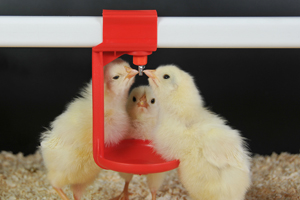How effective is your drinking water vaccination?

Water is a perfect medium to offer vaccines or liquid feed additives to poultry. The commonly used nipple or cup drinker systems have proven to be excellent watering systems, provided the system is properly made, maintained and used. Still, a lot can go wrong in water medication.
By Wiebe van der Sluis
Water is the most important nutrient for any living species. Providing water requires a watering system which has been made out of material that can be easily cleaned and maintained. It is often thought that any system will do and once you have it installed nothing can go wrong. The reality however tells a different story.Field research done by CEVA Animal Health showed that the results of drinking water vaccination against Gumboro (IBD) at many farms did not meet the required coverage of 95+%. In reality about 27% of the birds were not vaccinated at all and almost 30% did not receive enough vaccine or not at the right time. These poor results required further investigations and showed that poor management practices were the cause of it. Most flock managers believed that they had done a good job until the facts were presented.
Apart from timing, they believed that at start of vaccination the pipes were clean and empty. A closer look however showed the opposite. Even those who properly cleaned the pipes had to accept that “empty” pipes were not empty. This was especially the case in those watering lines that have nipples attached to the pipe with a long screw pin inside the pipe. These may leave water at the bottom of the pipe, up to the top of the screw. The remaining water is thinning the vaccinated water and is reducing the effectiveness of the vaccine (Figure 1). Providing a higher dose is not a solution here, because most of the time the water left behind in the pipe is pushed forward in the pipe filling the end of the pipe with thinned or clean water. The CEVA field test showed that even within one house there can be huge differences between filling water lines with vaccinated water. Some can be properly charged with vaccinated water while the next line can be filled 50-90% with vaccinated water and 50-10% clear water (Figure 2).
Clean and empty
To prevent problems caused by improper distribution of vaccines and or liquid feed additives it should be clear that the whole drinking water system should be cleaned before adding vaccinated water. There is a common misconception that chlorinated water does not require any maintenance and lines do not have to be flushed. This is absolutely incorrect. Public water, treated well or surface water may reduce the severity of contamination in the lines, but a biofilm may still appear. Regardless of the water quality or water source, it is highly recommended to clean the water lines between flocks and flush it properly with clean chlorine-neutralised water, so no disinfectant or cleaning solution is left behind. The grower will realise significantly higher productivity and profits over time with a proactive versus a reactive sanitation programme.
After flushing watering systems it should be clear that no water remains in the lines. Only then one can start preparing the system and the flock for vaccination by winching the empty lines up from the floor and leaving the flock without water for about two hours. In case lifting the system is impossible one should dim the lights to give rest to the birds.
Meanwhile the watering system can be prepared for filling the lines with vaccinated water. Make sure that every single line is filled to the end with the desired quantity of vaccinated water. This can be checked by using blue dye in the water solution. The coverage should be at least 90% to be effective. Once fully charged the drinkers can be lowered to provide access to the thirsty flock. To ensure that all birds will take in enough medicated water one should walk through the house to raise the birds and force them to get closer to the drinkers. Repeated walking in the house improves the intake of water and the serological result of the water medication. CEVA showed that the number of negatives dropped from 33% to 19% when the walking frequency over the 2-3 hour vaccination time went up from one to repeatedly.
Importance of water quality
As soon as the stock solution is finished the water lines including the dosing system has to be flushed with clean water so no residues will be left behind. Residues may have a negative effect on the functioning of the watering system and drop the flock performance. The question however is: “What is clean water?” Chickens, like people, require drinking water that is of good quality, safe and without an unpleasant taste. It should be tested for the presence of bacteria and other microbes, for the levels of minerals that occur naturally in the water, and for other chemical and physical factors.
Standards for animal drinking water indicate that there should be fewer than 100 bacteria of all types per millilitre (ml) of water and fewer than 50 coliform bacteria per ml (see Table 1). Recent field research indicates that a bacteria level of zero may be desirable to obtain optimum performance.
Ensuring vaccine persistence
Poor water quality, can retard growth, curtail egg production, or produce lower egg quality. Feed conversion, for example, has been positively correlated to the presence of sulphate and copper concentrations in the water, and livability with potassium, chloride, and calcium. Body weight is positively influenced by water hardness and dissolved oxygen, and negatively influenced by total bacteria and a pH less than 6.0. While several elements can cause poor water quality, the interaction between elements is more significant in water quality problems than the simple fact of their presence.
When using well or surface water the use of a filter is absolutely necessary. This water may contain dirt and chemicals that may interfere with a proper functioning of the watering system and/or vaccines. A Vietnamese producer learnt this the hard way. He complained about leaking and blocked nipples, while filters had been installed. When watering system provider Impex director Richard Wentzel visited the farm to find the reasons for the problems he discovered that the farm workers had taken away the filters because they were fed up with cleaning the filters a couple of times per day. This proved to be ‘a penny wise but pound foolish decision’.
Filters have limited or no effect on reducing the hardness of water. Hard water may cause stains, leave residues, or cause other physical problems in water-handling equipment, but seem not to have either a positive or a negative impact on poultry performance. In treating hard water that is to be used as drinking water for poultry, however, care should be taken not to increase any existing chemical imbalance in the water and that it does not interfere with the persistence of the vaccines.









